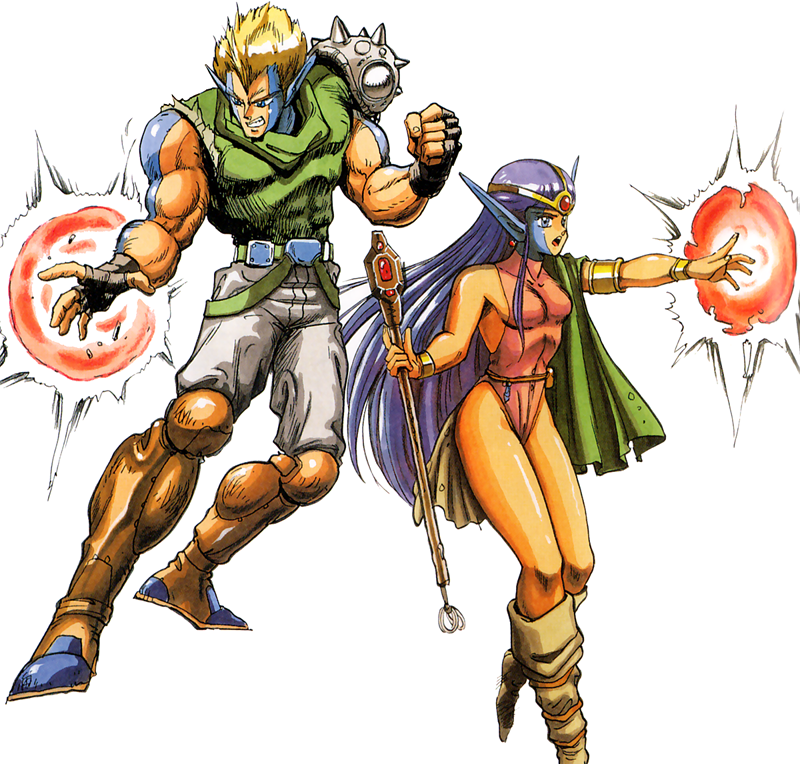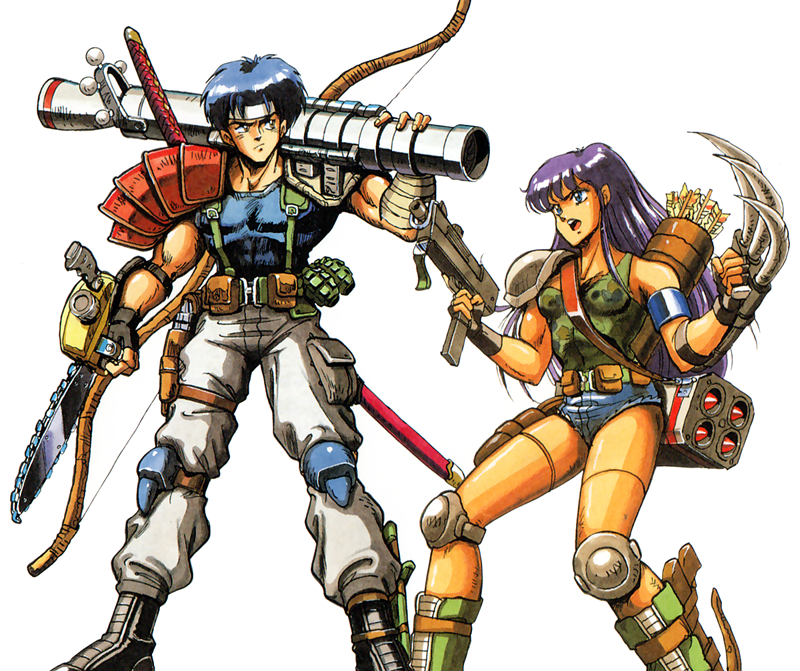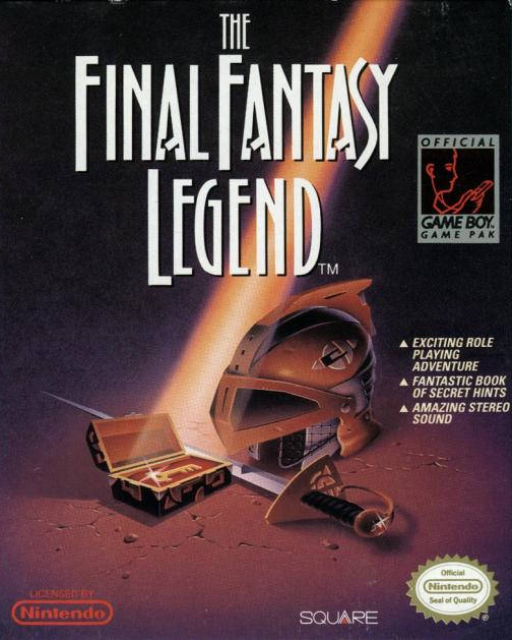The Curiosity of the First Game Boy RPG.
Final Fantasy Legend was originally released as SaGa: Warrior in the Tower of the Spirit World in Japan, the first title in the SaGa franchise by SquareSoft. It was the first RPG to be released for the Gameboy, and was also the first SquareSoft RPG to cross 1 million in sales in Japan, with 1.15 million in local sales. It would be another 2 years, with the release of Final Fantasy IV, before SquareSoft would have another RPG cross these sales numbers in their home country. (The original Final Fantasy games would eventually cross 1 million sold in Japan with their subsequent re-releases.)
Hoping to capitalize on the success of Final Fantasy internationally, which actually sold slightly more copies abroad than in Japan, the localization of this game was renamed Final Fantasy Legend. Unfortunately, the name recognition failed to give this unusual game much success outside of its native land. That lack of international success may be due to just how odd this game can be.
Final Fantasy Legend came out when RPGs were still fairly new to consoles, and developers were still experimenting with new ideas. Unlike most RPGs at the time, Inns did not charge a flat fee, but would charge 1 gold per HP recovered. If you couldn't pay the full amount, you couldn't heal or restore abilities. This creates an early game where you need to earn more gold per battle than damage received. If you failed to do this, you basically soft-locked yourself into losing the game. Given the different strengths of early classes this is surprisingly easy to do. Luckily this tends to become less of an issue as the game progresses.
Speaking of classes, there are 3 main varieties of which you will pick 4 to start your main party: Humans, Mutants, and Monsters.
Humans can only gain stats by buying and drinking potions, a hilariously broken system. You'll notice early on that the price of Strength and Agility potions do not change, and each gives a static +1 bonus, making it fairly easy to grind up to 99 Strength and/or Agility early in the game. However, 99 is just the visible limit for Strength and Agility, as the saved variable actually goes up to 255. This allows players to feed their human characters steroids... er, potions... until they get unbelievably deadly. The only catch being that the variable will wrap back around to 1 if the number goes past 255, and the player can only see the stat if the variable is below 99.
The developers must have sensed that steroid / potion system for Strength and Agility was broken, because they actually put limits on the HP Potions. HP Potions come in three varieties: HP200, HP400, and HP600. Each gives you somewhere around 1-20 HP per potion until you reach the limit on the bottle, after which it only gives 1HP per beverage. This limits the player to certain soft HP caps until they can find and afford the next level of HP Potions. However, once again, the system is slightly off. HP600 is so expensive that it's actually cheaper to buy around 20x HP200 potions for 1HP a pop than it is to buy a single HP600 potion. The downside is that this a laborious process, as you only get 8 general items slots, not counting what the limited item slots Humans and Mutants can carry, and each potion takes up a single slot.

Mutants are the closest to a traditional RPG class, in that they gain stats randomly after battle. Of the 8 inventory slots given to Humans and Mutants, 4 of the Mutant's slots will be filled with random pseudo-magic abilities that have a chance to change after every battle. These can mimic either monster abilities, the abilities cast by spell books, or just give immunity to spells or surprise attacks. Mutants are also the only class that can continuously increase their natural defense and magic abilities, which mitigates their inability to wear as much armor as humans (due to having less item slots) and makes them the game's default magic class.
Monsters are an interesting idea that was much better developed in the sequel to this game, but ended up a frustratingly weak and punishing class to use in the original. Monsters are exactly that: the monsters you face in the game. Each is assigned a hidden type and monster level, and by eating the meat of fallen monsters after battle, your Monsters will become a new type and level by comparing their current type & level with the meat of the monster they ate. The problem is that most monsters are not designed to be traveling in a party, but rather be cannon fodder to be plowed through by the player to reach items and bosses. This means that your Monsters will constantly feel weak compared to your Humans and Mutants. They also tend to have low ability usage, though like Mutant abilities, they do recharge after staying at an Inn. Unlike Mutants however, these are the only attacks Monsters have, as they cannot equip weapons, armor, or items.
(Interesting aside: Final Fantasy Legend I & II and the monster system are mentioned as one of the inspirations for Satoshi Tajiri to create Pokémon for the Game Boy, as noted in a June 2009 interview.)
As for equipment, it is all limited use. Most weapons and spell books come with 50 charges, and they do not charge upon rest like Mutant and Monster abilities. This is not a big problem with proper gold management, a big theme of this game, though it can take some time to get used to. Even rare items have this limited use, though it's not wise to save most of them (except the chainsaw) as inventory is limited. Of note are the fact that this game's weapons range from medieval weaponry, to martial arts, to sub machine guns, to laser swords, and even a nuclear bomb. The game booklet has great images of Humans simultaneously holding a bow, a bazooka, some grenades, a chainsaw, and a katana. It's great.

The final game mechanic of note is the heart system. Each character gets 3 hearts. You can revive a dead character, but they lose a heart. Once that character is out of hearts, they're permanently dead. Now, you can buy new hearts, but they run 10,000 GP. In an early game where you are grossing 40 GP per battle (not including gold loss due to HP recovery at the Inns), this is a monumental task and it remains so until very late in the game.
Mechanics out of the way, what of the story? Well, this is the first Game Boy RPG stuffed onto a 256kb cartridge, so I hope you're not expecting Xenogears. You start out as a hero born in a world at the bottom of a great tower. The tower reaches into the heavens and multiple worlds. It's said that the tower leads to paradise, but no one has been able to enter the tower in some time. That's when you assemble a posse, take the advice of Tuxedo Mask... er, some hat guy... and go busting in the door. You come across a number of distinctly different worlds, and in the end you'll come face to face with... well, that would be spoiling. The ridiculousness of the final battle is genuinely one of my favorite little JRPG plot points, even if the plot of most of the game is pretty sparse.
The music is surprisingly good for a very early Game Boy title. Like many parts of this game, it gets much better in the sequel, though I would find myself humming along at times.
Overall, this is a challenging game that requires you defy your traditional expectations of Japanese console RPGs. It can be very frustrating to start and learn the systems, though you can quickly break the difficulty curve over your knee (unless you start with more than one Monster party member). I personally could not recommend this game to modern gamers unless they have a lot of experience with JRPGs, especially from the NES / Game Boy era. Like many games from this era, this game is a curiosity best enjoyed by people that can understand its place in gaming history, rather than a shinning example of the genre itself. Even if you are interested in JRPGs from this era, I would still recommend cutting your teeth on early Final Fantasy or Dragon Quest before coming here. Well... maybe not Dragon Quest 2. That game is tedious.
That said, this game does have a lot of charm. Definitely give it a shot if you're a fan of the era and your backlog is looking manageable.
